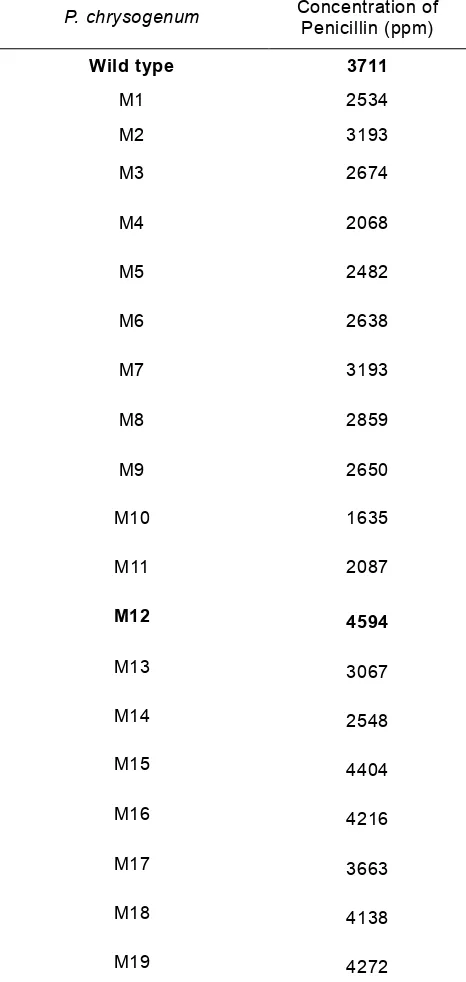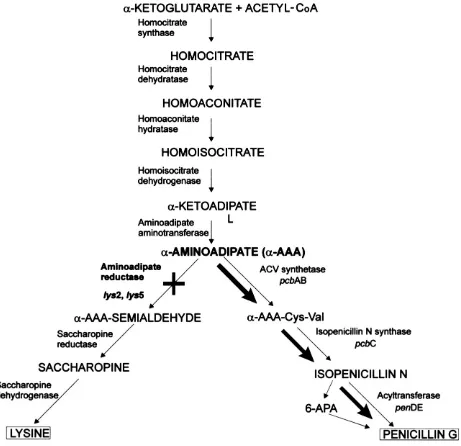VOLUME 2
NOMOR 1
JUNI 2015
ISSN 2442 - 2606
JURNAL
BIOTEKNOLOGI & BIOSAINS INDONESIA
Homepage Jurnal: http://ejurnal.bppt.go.id/index.php/JBBI
PENICILLIN PRODUCTION BY MUTANT OF
Penicillium chrysogenum
Produksi Penisilin oleh Mutan
Penicillium chrysogenum
Dudi Hardianto*, Suyanto, Erwahyuni E Prabandari, Lira Windriawati, Edy Marwanta, Tarwadi Biotech Center BPPT, Building 630 PUSPIPTEK Area, Setu, Tangerang Selatan, Banten 15314
*E-mail: dudi.hardianto@bppt.go.id
ABSTRAK
Penisilin adalah antibiotika yang pertama kali ditemukan dan digunakan untuk pengobatan infeksi bakteri. Sejak ditemukan penisilin sebagai antibiotika oleh Alexander Fleming pada tahun 1928, banyak usaha dilakukan untuk meningkatkan produktivitas Penicillium chrysogenum. Pemuliaan galur untuk meningkatkan produksi penisilin dapat menggunakan mutasi acak secara fisika dan kimia. Pada penelitian ini, radiasi sinar ultraviolet digunakan untuk mendapatkan mutan P. chrysogenum. Produksi penisilin ditentukan menggunakan HPLC dan produktivitas mutan dibandingkan dengan induk P. chrysogenum. Mutan M12 menghasilkan penisilin 1,23 kali lebih banyak dibandingkan dengan induk P. chrysogenum.
Kata kunci: Penisilin, Penicillium chrysogenum, ultraviolet, mutan, radiasi
ABSTRACT
Penicillin is the first antibiotic discovered and used for treatment of bacterial infections. Since the discovery of penicillin as antibiotic by Alexander Fleming in 1928, much effort has been invested to improve productivity of Penicillium chrysogenum. Strain improvement to increase the penicillin production can be carried out by physical and chemical random mutation. In this research, ultraviolet irradiation was used to obtain P. chrysogenum mutant. Penicillin production was determined by using HPLC and productivity of P. chrysogenum
mutants was compared to the wild type. Mutant M12 produced 1.23 fold higher penicillin than the wild type did.
INTRODUCTION
Penicillin is the first antibiotic discovered and used for treatment of
bacterial infections. The structure of β -lactam penicillin consists of a bicyclic
nucleus formed by a β-lactam ring and a thiazolidine ring containing a sulfur atom and an acyl side chain bound to the amino group present at C-6 (Liras dan Martin 2006). Although some bacteria are resistant to penicillin, this antibiotic is still widely used today. Penicillin is used in treatment of many gram-positive bacterial infections, such as Staphylococcus
pyogenes (strep throat) and
Streptococcus pneumoniae (respiratory
tract infection, otitis media) (Christensen et al. 2000; Rayamajhi et al. 2000). Bacterial cell wall synthesis is inhibited by penicillin. Penicillin binds to the enzyme transpeptidase that link the peptidoglycan molecules in bacterial cell wall.
Penicillin industrially is produced by the filamentous fungus Penicillium
chrysogenum and commercial production
of penicillin began in 1941 (Newbert et al. 1997). The production of penicillin by the submerged fed-batch fermentation in stainless tank reactors of 30,000-100,000 galon capacity is important for several decades (Elander 2003) and optimization of penicillin production is very important for the penicillin companies (Thykaer dan Nielsen 2003). Since the discovery of the production of antibiotics by Alexander Fleming in 1929, much effort has been invested in selection and synthesis of strains with improved productivity (Harris et al. 2009). Classical strain improvement with random mutation and screening has been used to obtain overproducing strains. The UV irradiation is the one of techniques for strain improvement and its technique is very effective for mutation unstable, mutagenic events are random and do not necessarily affect only the genes involved in antibiotic synthesis.
Re-storage of high producing strains is needed to know stability of mutants.
The increase in penicillin fermentation productivity and high recovery yield (>90%) has led to significant cost reduction fispite increasing labor, energy, and raw materials costs. In range from $ 35 to 40/kg (Elander 2000).
The aim of this research was obtained P. chrysogenum mutant that produces higher amount of penicillin than wild type. Assessment and Application of Technology.
Mutation by UV irradiation
Czapek Dox Agar was used to select
P. chrysogenum mutants. A conidial from irradiated variated from 5-30 minutes with interval 5 minutes. 50 µL conidial suspension of the growth of P.
chrysogenum mutants were inoculated,
spreaded into Czapek Dox Agar plates, and the inoculated plates were incubated for 10 days at 28oC.
Isolation and selection of mutants
After 10 days, mutant colonies were separated by inoculation each mutant colony on Czapek Dox Agar plates. The inoculated plates were incubated for 10 days at 28oC.
Production of penicillin
One of mutants colony was inoculated in seed medium (6.1% corn steep liquor, 2.0 % sucrose, 0.5% CaCO3) and incubated in
suspension of inoculum was inoculated in
Broth of fermentation was centrifugated at 15000 g, and supernatant was filtered through filter 0.45 µm. 10 µL sample was injected to HPLC mechine from Waters with C18 column (Symmetry), mobile phase: 5 mM KH2PO4 and 6 mM H3PO4 : Acetonitrile (60 : 40), flow rate 1.0 mL/min, and ultraviolet
detector λmax: 210 nm.
RESULTS AND DISCUSSION
The survivals of P. chrysogenum
mutants were selected and tested for penicillin production. Penicillin yield of Mutants varied from 1635 to 4594 ppm. Mutant M12 produced 1.23 fold (4594 ppm) compared to wild type (3305 ppm) (Table 1.). The hyperproduction of mutant may be caused mutation of one or more biosynthesis of penicillin gene or the disrupsion of the lys2 gene (gene for lysine biosynthesis). The mutation of biosynthesis of penicillin gene may increase enzymes activity for penicillin production or disruption of the lys2
gene increase aminoadipic acid (precursor for penicillin biosynthesis).
Figure 1. Effect of UV exposure time on P. chrysogenum and mutants from 50% and above survivals were selected and used for production of penicillin
In P. chrysogenum the biosynthesis
of penicillin and lysine have several steps in common (Figure 2). It should be possible to increase penicillin production by the disrupsion of lys2 gene (Casqueiro et al. 1999). The poor result of penicillin of mutants may be caused by mutation in penicillin biosynthesis genes. The mutation of biosynthesis of penicillin gene may cause decrease enzymes activity for penicillin production.
Table 1. Penicillin production of mutants
P. chrysogenum Concentration of Penicillin (ppm)
Figure 2. Biosynthesis pathway of penicillin and lysine in P. chrysogenum (Casqueiro et al. 1999)
CONCLUSION
The penicillin yield of mutants var-ied from 1635 to 4594 ppm and mutant M12 from 30 minutes-irradiated produced 1.23 fold compared to wild type.
REFERENCES
Casqueiro J, Guteirrez S, Banuelos O, Hijarrubia MJ, Martin JF (1999) Gene targeting in Penicillium chrysogenum: disruption of the lys2 gene leads to penicillin Overproduction. J Bacteriol 181:1181-1188
Christensen B, Thykaer J, Nielsen J (2000)
Metabolic characterization of high- and low-yielding strains of Penicillium
chrysogenum. Appl Microbiol
Biotechnol 54:212-217
Elander RP (2003) Industrial production of β -lactam antibiotics. Appl Microbiol Biotechnol 61:385-392
Harris DM, van der Krogt ZA, Klaassen P, Raamsdonk LM, Hage S, van den Berg MA, Bovenberg RAL, Pronk JT, Daran J (2009) Exploring and dissecting genome-wide gene expression responses of
Penicillium chrysogenum to phenylacetic
acid consumption and penicillinG produc-tion. BMC Genom: 10:75
en-hancement of cyclosporin ‘A’ by
Aspergillus terreus throug mutation. Afr
J Biotechnol 11:1736-1743
Liras P, Martin JF (2006) Gene Cluster for β -lactam Antibiotics and Control of Their Expression: Why Have Clusters Evolved, and from Where did They originate? Int Microbiol 9:9-19
Newbert RW, Barton B, Greaves P, Harper J, Turner G (1997) Analysis of a com-mercially improved Penicillium
chrysogenum strain series:
involve-ment of recombinogenic regions in amplification and deletion of the peni-cillin biosynthesis gene cluster. J Ind
Microbiol Biotechnol 19:18-27
Parekh S, Vinci VA, Strobel RJ (2000) Im-provement of Microbial Strain and Fermentation Processes. Appl Microbiol Biotechnol 54:287-301
Ravalat J, Douki T, Cadet J (2001) Direct and Indirect Effect of UV Radiation on DNA and its Components. J Photochemist Photobiol 63:88-102 Rayamajhi N, Cha SB, Yoo HS (2000)
Anti-biotics resistances: past, present and future. J Biomed Res 11:65-80
Thykaer J, Nielsen J (2003) Metabolic

